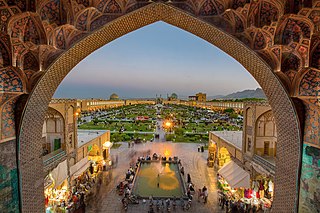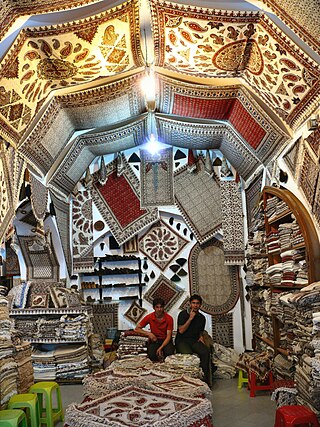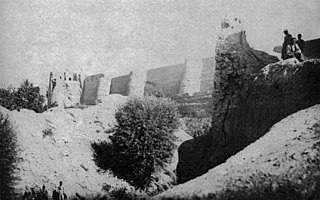
Isfahan, from its ancient designation Aspadana and, later, Spahan in middle Persian, rendered in English as Ispahan, is a major city in the Greater Isfahan Region, Isfahan Province, Iran. It is located 439.78 kilometres south of Tehran and is the capital of Isfahan Province. The city has a population of approximately 2,220,000, making it the third-largest city in Iran, after Tehran and Mashhad, and the second-largest metropolitan area.

Isfahan Province, also transliterated as Esfahan, Espahan, Isfahan, or Isphahan, is one of the thirty-one provinces of Iran. It is located in the center of the country in Iran's Region 2. Its secretariat is located in the city of Isfahan.

A bazaar or souk is a marketplace consisting of multiple small stalls or shops, especially in the Middle East, the Balkans, North Africa and India. However, temporary open markets elsewhere, such as in the West, might also designate themselves as bazaars. The ones in the Middle East were traditionally located in vaulted or covered streets that had doors on each end and served as a city's central marketplace. Street markets are the European and North American equivalents.

Naqsh-e Jahan Square, also known as the Shah Square prior to 1979, is a square situated at the center of Isfahan, Iran. Constructed between 1598 and 1629, it is now an important historical site, and one of UNESCO's World Heritage Sites. It is 160 metres (520 ft) wide by 560 metres (1,840 ft) long. It is also referred to as Shah Square or Imam Square. The square is surrounded by buildings from the Safavid era. The Shah Mosque is situated on the south side of this square. On the west side is the Ali Qapu Palace. Sheikh Lotf Allah Mosque is situated on the eastern side of this square and at the northern side Qeysarie Gate opens into the Isfahan Grand Bazaar. Today, Namaaz-e Jom'eh is held in the Shah Mosque.

Ali Qapu Palace or the Grand Ali Qapu is an imperial palace in Isfahan, Iran. It is located on the western side of the Naqsh-e Jahan Square, opposite to Sheikh Lotfollah Mosque, and had been originally designed as a vast portal entrance to the grand palace which stretched from the Naqsh-e Jahan Square to the Chahar Baq Boulevard. The palace served as the official residence of Persian Emperors of the Safavid dynasty. UNESCO inscribed the Palace and the Square as a World Heritage Site due to its cultural and historical importance. The palace is forty-eight meters high and there are six floors, each accessible by a difficult spiral staircase. In the sixth floor, Music Hall, deep circular niches are found in the walls, having not only aesthetic value, but also acoustic. Ali Qapu is regarded as the best example of Safavid architecture and a symbol of Iran's Islamic heritage.

Isfahan County is located in Isfahan province, Iran. The capital of the county is Isfahan. At the 2006 census, the county's population was 1,963,315, in 543,688 households. At the 2016 census, the county's population was 2,243,249, in 707,870 households.

The Fire Temple of Isfahan is a Sassanid-era archaeological complex located on a hill of the same name about eight kilometers west of city center of Isfahan, Iran.

The Grand Bazaar is a historical market located in Isfahan, Iran, also known as the Qeysarriyeh Bazaar, Qeysarie bazaar or Soltani bazaar. The main commercial activities in the Qeysarie bazaar are carpet and kilim selling.

Ghehi is a village in Emamzadeh Abdol Aziz Rural District, Jolgeh District, Isfahan County, Isfahan Province, Iran. At the 2006 census, its population was 768, in 200 families.

The Jalali Castle is located in Kashan, Iran.

The Mesri Mosque is a historical mosque in Isfahan, Iran. The mosque was built in 1650 in the Safavid era. There is an inscription in its mihrab, written by the famous calligrapher Mohammad Reza Emami in Nastaliq script.
The Safa Mosque is a historical mosque in Isfahan, Iran. The mosque was built by Mohammad Golestaneh in the Qajar era and is located near the Shahshahan mausoleum.
Azadi Metro Station is a station on Isfahan Metro Line 1. The station opened on 20 July 2017. It is located on Azadi Square, also known as Darvazeh Shiraz. The next station on the north side is Shari'ati Station. The station is located next to University of Isfahan campus.
Saint Minas Church of New Julfa,, is an Armenian Apostolic church in New Julfa, Iran. It is located in Davrezh neighbourhood of New Julfa.

The government of Isfahan consists of a mayor and a 13 member municipal legislature. The Isfahan National Holy Association was involved in the Persian Constitutional Revolution. The politic of Isfahan is based on the 1979 Constitution, which made the country a theocratic Islamic republic in which the various powers are overseen by a body of clerics.

Isfahan Fair is a trade fair in Isfahan City. Its Chief Executive Officer is Ali Yarmohammadian.

Isfahan international convention center Persian: مرکز همایشهای بینالمللی اصفهان is a convention center under construction in Isfahan, Iran.

Tabreh Castle was a historical castle in Isfahan County in Isfahan Province, The longevity of this fortress dates back to the Sasanian Empire.

The Isfahan Seminary is one of the oldest seminaries in Isfahan, Iran. Currently, more than 40 schools in Isfahan province are under the supervision of the Management Center of Isfahan Seminary and the leadership of the supreme authority of Grand Ayatollah Hossein Mazaheri.
Noureddin Esheni Qudejani or Noureddin Qudejani Esheni was an Iranian Shia cleric, famous preacher and orator of Isfahan, Faqih, lawyer and professor of Isfahan Seminary. He was the famous Salah al jama'ah imam of the Seyyed Mosque of Isfahan. He was one of the modernist clerics and the first cleric to study law and become a lawyer.



















